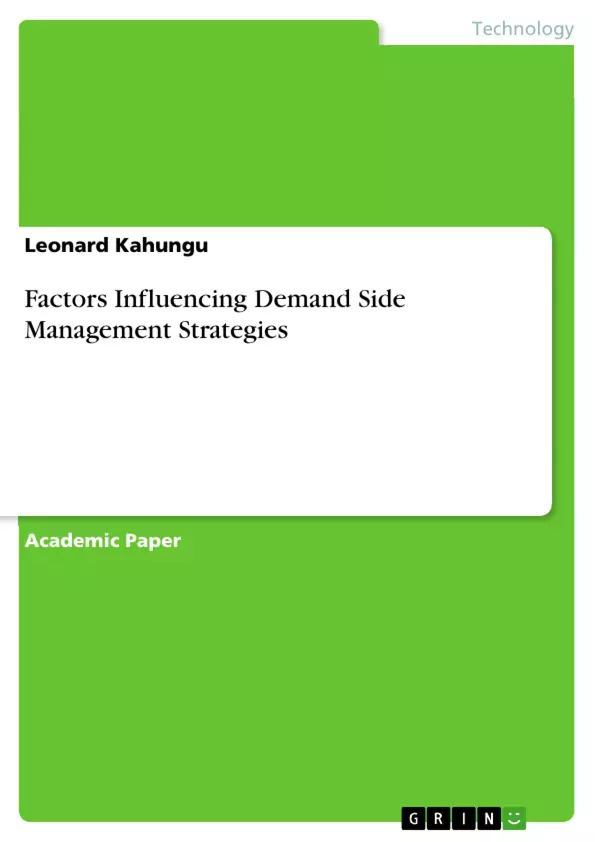The future of UK's energy industry is currently facing significant threats attributed to dwindling energy resources and escalating energy demand. Demand side management strategies can play a central role in facilitating the UK to smoothly transition from relying on conventional energy production systems to modernised systems that are more reliable due to reduced production costs and enhanced yields. The DSM strategies are predominantly divided into three types namely demand side reaction, distributed generation, and demand reduction.
Demand-side responses are concerned mainly with short-term actions characterising the consumers in attempts to modify their power consumption patterns. Distributed generation seeks to establish localized energy generation and distribution to offset the demand load in macro grid power systems. Demand reduction is caused by escalating population growth and the increase of technological appliances and seeks to reduce the energy stress in macro grid power networks. Reducing energy demand explores significant ways to influence consumer behaviours and to enhance power consumption efficiency.
Each of DSM groups is affected by technological, financial, and institutional factors. Financial aspects explore monetary benefits and barriers while technological factors deal with technical potential and challenges inhibiting successful implementation of DSM strategies. The institutional elements mostly focus on regulatory issues influencing demand-side management strategies. Thus, the primary recommendations in the UK’s context are concerned with technical developments and policy reconstitution to facilitate secure and sustainable energy management.
Inhaltsverzeichnis (Table of Contents)
- Executive Summary
- Factors Influencing Demand Side Management Strategies
- Demand Side Management
- Types of Demand Side Management Strategies
- Demand Side Response
- Financial Aspects
- Technological Aspects
- Institutional Aspect
- Distributed Generation
- Financial Aspects
- Technological Aspects
- Institutional Aspect
- Demand Reduction
- Financial Aspects
- Technological Aspects
- Institutional Aspect
- Conclusion
- Recommendations
- References
Zielsetzung und Themenschwerpunkte (Objectives and Key Themes)
This report explores the factors influencing demand side management (DSM) strategies in the UK energy sector. It emphasizes the significance of DSM in facilitating a smooth transition from traditional energy production systems to modernized, more sustainable and efficient systems.
- The challenges facing the UK energy system due to dwindling resources and increasing demand.
- The role of DSM strategies in addressing these challenges and contributing to a secure and sustainable energy future.
- The three primary types of DSM strategies: demand-side response, distributed generation, and demand reduction.
- The key factors affecting the effectiveness of each DSM strategy, including financial, technological, and institutional aspects.
- Recommendations for policy and technical advancements to facilitate the successful implementation of DSM strategies in the UK.
Zusammenfassung der Kapitel (Chapter Summaries)
The executive summary provides an overview of the UK energy system's current challenges and the potential of DSM strategies to address them. It introduces the three main categories of DSM: demand-side response, distributed generation, and demand reduction. Each category is influenced by financial, technological, and institutional factors.
The chapter on demand-side management (DSM) defines DSM as a set of strategies aimed at reducing energy consumption through innovative programs and activities that promote energy efficiency and conservation.
The chapter on demand-side response (DR) explains how DR programs encourage consumers to modify their energy consumption patterns in response to price signals or grid operator directives. The financial aspects of DR include the potential for cost savings for both consumers and utilities. The chapter also discusses technological aspects, such as the use of smart meters and communication technologies, and the institutional factors, such as regulatory frameworks, that influence the implementation of DR strategies.
The chapter on distributed generation explores the concept of localized energy generation and distribution, offering a means to offset demand loads in macro grid power systems. It examines the financial, technological, and institutional aspects of distributed generation.
The chapter on demand reduction focuses on reducing energy consumption through measures such as promoting energy efficiency and changing consumer behavior. It delves into the financial, technological, and institutional aspects of demand reduction, highlighting the importance of regulatory frameworks and policy incentives.
Schlüsselwörter (Keywords)
This study focuses on key aspects of demand-side management (DSM), emphasizing the role of DSM in facilitating a sustainable and secure energy future for the UK. Key themes include the challenges facing the UK energy system, the different types of DSM strategies (demand-side response, distributed generation, and demand reduction), and the financial, technological, and institutional factors influencing their effectiveness. It explores the need for policy and technical advancements to ensure the successful implementation of DSM strategies in the UK.
- Quote paper
- Leonard Kahungu (Author), 2018, Factors Influencing Demand Side Management Strategies, Munich, GRIN Verlag, https://www.grin.com/document/428650



